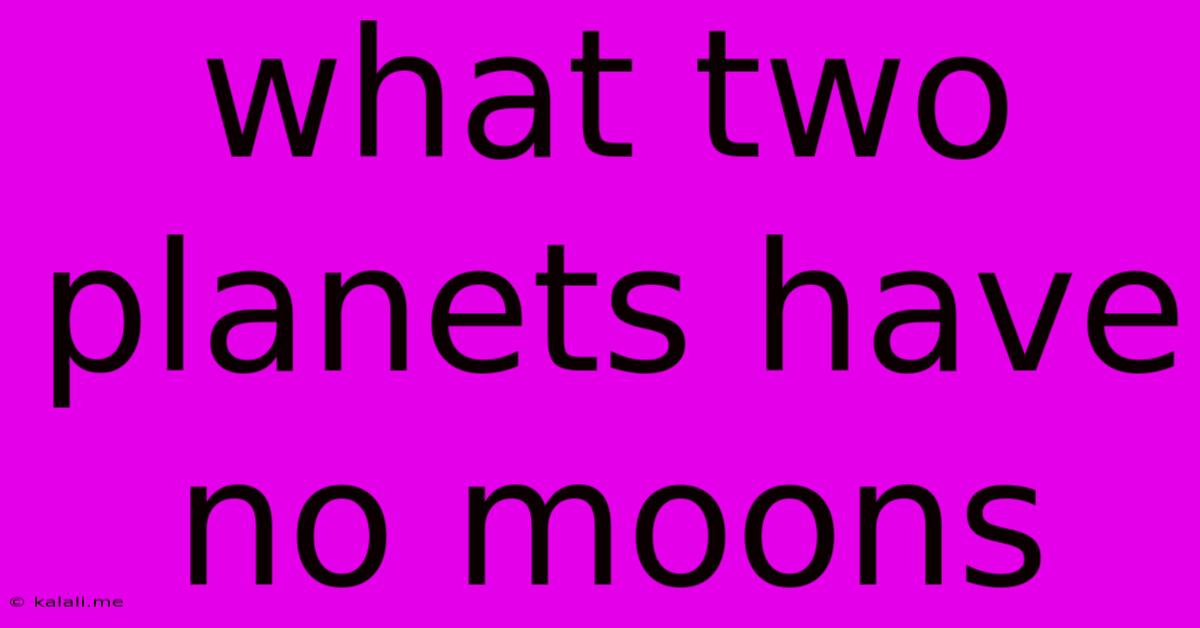What Two Planets Have No Moons
Kalali
May 10, 2025 · 3 min read

Table of Contents
What Two Planets Have No Moons? A Celestial Mystery
Meta Description: Discover the two planets in our solar system that lack natural satellites – moons! Learn about their unique characteristics and why they don't have orbiting moons. Explore the fascinating world of planetary science.
Our solar system is a vibrant tapestry of planets, each with its own unique characteristics. From gas giants with dozens of moons to rocky planets with a few, or even none, the diversity is captivating. But one question often arises: which planets in our solar system don't have any moons at all? The answer might surprise you: only two planets in our solar system are confirmed to have no moons: Mercury and Venus. This absence of natural satellites makes them rather unique compared to their planetary neighbors. Let's delve deeper into why this is the case.
Mercury: A Moonless World Closest to the Sun
Mercury, the smallest and innermost planet, presents a fascinating case. Its proximity to the Sun plays a significant role in its moonless status. The intense gravitational pull of the Sun likely prevented the accretion of any material necessary to form a moon during the planet's formation. Any smaller celestial bodies that might have been captured by Mercury's gravity likely were flung out of orbit by the Sun's immense gravitational influence. Furthermore, Mercury's relatively small mass also contributes to its inability to hold onto a moon, as the planet’s gravitational pull would be insufficient to keep a captured object in a stable orbit. Essentially, the sun's gravity is just too strong for Mercury to maintain a moon.
Venus: A Mysterious Sister Without Lunar Companions
Venus, Earth's closest planetary neighbor, shares a similar moonless fate. Unlike Mercury, Venus's distance from the Sun isn't the primary reason for its lack of moons. The prevailing theory suggests that a significant impact event, a collision with a large celestial body, might have either prevented moon formation or destroyed any moons that may have formed earlier. Alternatively, it's possible that the planet's thick atmosphere and the influence of solar radiation could have destabilized any orbiting moons over time, causing them to either collide with Venus or be ejected from orbit. The exact reasons remain a subject of ongoing scientific inquiry and research.
The Search for Explanations and Future Discoveries
While the absence of moons for Mercury and Venus is currently well-accepted, the exact mechanisms behind this lack of satellites continue to be explored by planetary scientists. Future missions and advanced observations might reveal additional details and perhaps even challenge the existing theories. Understanding the reasons behind the moonless nature of these planets provides crucial insights into the formation and evolution of our solar system. The contrast between these two moonless planets and their neighboring worlds with rich lunar systems highlights the complex interplay of gravitational forces, collisions, and other factors that shaped the solar system we see today.
The mystery of Mercury and Venus's moonless existence serves as a reminder of the dynamic and unpredictable nature of celestial bodies and the continuing quest to unravel the secrets of our universe. This continuous exploration of our solar system helps us refine our understanding of planetary formation and the diverse conditions that can lead to such contrasting results.
Latest Posts
Latest Posts
-
Can You Use A Regular Light Bulb In A Refrigerator
Jun 01, 2025
-
How Do You Shell Pinon Nuts
Jun 01, 2025
-
Cannot Find Lliburing No Such File Or Directory
Jun 01, 2025
-
How To Write Song Lyrics In A Story
Jun 01, 2025
-
Go On With Your Bad Self
Jun 01, 2025
Related Post
Thank you for visiting our website which covers about What Two Planets Have No Moons . We hope the information provided has been useful to you. Feel free to contact us if you have any questions or need further assistance. See you next time and don't miss to bookmark.